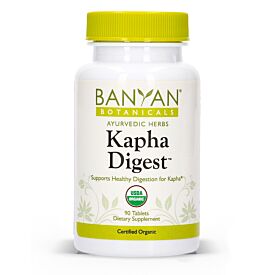The Three Stages of Life

According to Ayurveda, different stages of our lives are deeply influenced by each of the three doshas—vata, pitta, and kapha. Childhood, which is the first stage, is governed by kapha dosha. The second stage, from puberty up to the age of fifty, is governed by pitta dosha. And the third stage, which is from the age of fifty until death, is governed by vata dosha. While this perspective might seem obscure and complex at first, when we take a closer look, these correlations are actually quite intuitive. And in fact, this frame of reference can be very useful in helping us to appreciate both our strengths and our vulnerabilities as we grow, age, and mature.
Keep in mind that the transition between these separate stages does not occur overnight. Instead, it is a gradual transition in which the influence of one dosha begins to decline just as the influence of another dosha begins to increase. This process continues until the transition is complete, which could take several years. So it’s not as if we wake up on the morning of our fiftieth birthday and have suddenly moved from the pitta stage of life to the vata stage. But around that time, we can observe the gradual reduction of pitta’s influence in favor of more and more vata.
The Ayurvedic Context
Before we dive into the stages themselves, it is important to understand that Ayurveda views all substances and experiences through a qualitative lens in which like qualities increase one another and opposites can be used to promote balance. For example, summer is a hot season. Similarly, pitta is a fiery, hot dosha. So a pitta-predominant individual living in a warm climate during the summer season is very likely to be experiencing excess heat in some form or fashion. This might present in any number of ways: acid indigestion, diarrhea, increased body temperature, skin rashes, and acute inflammation, to name a few. In turn, the Ayurvedic remedy would be to offset the accumulating heat by introducing cooling influences through diet, lifestyle, and appropriate herbs.
In essence, the kapha, pitta, and vata stages of life are successive periods during which we have a natural, physiological increase in the qualities that characterize each of the doshas. For example, during the kapha stage of life, the qualities of kapha are inherently increased in the body, which lends children enhanced access to kapha’s strengths, but—because like increases like—simultaneously increases their likelihood of experiencing a kapha imbalance. And the way to prevent or address kapha imbalances in children is to increase their exposure to specific kapha-pacifying qualities that help to promote balance.
On the other hand, your particular stage of life is one of many factors to consider when assessing your path toward optimal health. At any given time, both your prakriti (Ayurvedic constitution) and your vikriti (current state of balance) will likely influence the therapeutic strategies most appropriate for you, as will your climate and your lifestyle. If you do not know your prakriti or vikriti, our Ayurvedic Profile™ quiz will help you identify them. Please keep in mind that a significant imbalance in any of the three doshas always trumps whatever stage of life we might be in. For instance, a young child who experiences a traumatic event will tend to have elevated vata in her system and will need vata-pacifying measures to help restore balance, despite being in the kapha stage of life. Still, an educated awareness of the kapha, pitta, and vata stages of life allows us to anticipate the compounding impact of each of the doshas at different ages, and where appropriate, affords us the opportunity to make proactive choices to improve our overall health and well-being. We hope that the following information will help you to do just that.

Childhood: The Kapha Time of Life
This first, kapha stage of life, lasts from birth until puberty—roughly the first sixteen years of life.1 This time of life is supported by and infused with an increase in the primary qualities of kapha.
| The Kapha Stage at a Glance | |
|
Approximate Timeframe: |
Birth to Sixteen Years of Age |
|
Primary Elements: |
Water, Earth |
|
Qualities of Kapha: |
Heavy, Slow, Cool, Oily, Smooth, Dense, Soft, Stable, Gross, Cloudy |
|
Functions of Kapha: |
Structure, Cohesion, Lubrication, Hydration, Growth, Nourishment |
The Nature of Kapha Dosha
Kapha is composed primarily of the water and earth elements. Of the three doshas, it is undoubtedly the densest and most solid. Kapha is heavy, slow, cool, oily, smooth, soft, stable, gross, and cloudy, and it lends the body structure, cohesiveness, lubrication, hydration, and nourishment, while supporting anabolic (building) bodily processes and growth.
The Nature of Childhood
The correspondence between kapha and childhood is very straightforward. Childhood is about growth, building new tissue, accumulating body mass, and rapidly increasing the weight of the physical body as it grows. The body needs a tremendous amount of kapha in order to pull this off. In other words, the rapid growth and development, the constant generation of new cells and tissues that characterizes childhood, is a process that is inherently governed by kapha. There is an elegant intelligence in buffering the body with extra kapha during this stage of life.
Kapha also regulates body fat, which naturally helps to buffer and provide fuel for our bodies during this intensely growth-oriented time period. It is for precisely this reason that a properly nourished child is padded with a layer of “baby fat.” Of course, one’s constitution is a factor; vata- and pitta-predominant children may carry less baby fat than kapha-predominant children, but provided they have access to proper nutrition, all children are naturally a bit chubbier than their balanced, adult self. In fact, if you review a photo history of a healthy individual from infancy to adulthood, you can watch this buffer of fat appear on their bodies in the months after birth and then gradually fade away—appearing to melt off of them as the child matures into adolescence and adulthood.
Children are actually incredibly attuned to the natural correspondence between childhood and the building, nourishing nature of kapha. On a cellular level, children crave sweet, grounding, and anabolic foods that will support the incredible undertaking of growing an adult human body. These qualities can be found in foods rich in the sweet taste such as whole grains, legumes, root vegetables, milk, and many other healthy, nourishing foods, which kids tend to favor. It just so happens that now, unlike any other time in evolutionary history (in the developed world at least), we have access to an abundance of processed foods with a similar qualitative profile—and our children flock to them. This is why kids tend to love bread, mac and cheese, french fries, and other building, kapha types of foods. Even sugar, though rather nutritionally empty, can satisfy a child’s physiological craving for the sweet taste, which can quickly become problematic for a child’s health.
Childhood Vulnerabilities
Being the wet, heavy dosha that it is, the extra kapha in our systems during childhood also introduces certain predictable vulnerabilities. Common kapha imbalances include congestion, coughs, runny noses, frequent colds, and excess mucus. Sound like any kids you know?
This increased kapha influence is complicated by the fact that childhood is also the stage during which we develop immunity. Some is passed from our mothers via breast milk and other means, but mostly, robust immunity is established through exposure to various microbes—which means that we have to get sick in order to build up a healthy immune system. So healthy children can be expected to get sick more often than healthy adults, but they should also be able to weather their colds relatively quickly and easily.
Yes, our children will inevitably get sick from time to time, but we can help to keep their kapha symptoms mild, and encourage a quick recovery. Routine colds need not travel deep into their lungs or sinuses and should clear up within a few days. Similarly, we can help to prevent or mitigate childhood asthma, allergies, and other common kapha-induced challenges. On the other hand, if kapha is unduly elevated in a child’s system, a routine cold can result in a junky cough that lasts for weeks, or a nose that seems to run all winter long.
Supporting Balance During the Kapha Stage of Life
We cannot bypass the systemic increase in kapha that accompanies childhood (nor would we want to), but we can certainly support our children in keeping predictable kapha-imbalances at bay. A few simple considerations can provide deep support to children, and can help to ensure that the natural buffer of extra kapha remains just that: a buffer, not an imbalance. This can be accomplished by introducing more lightness, sharpness, heat, dryness, roughness, fluidity, mobility, subtlety, and clarity into our children’s lives.
Diet
Because kapha is inherently the most tangible of the three doshas, it is well-served by a diet that promotes balance. Light, warm, heating foods that are naturally dry or astringent, fibrous (rough), and clarifying are fabulous for balancing kapha. An abundance of fresh fruits, vegetables, legumes, and whole grains, will generally do wonders for balancing kapha. It is also extremely helpful to cook with plenty of warming, digestive spices like garlic, ginger, cinnamon, and turmeric. In fact, most spices balance kapha, so get creative with them. Sprinkling a bit of Trikatu powder (the same formula found in Kapha Digest tablets) on a child’s food like pepper can help to kindle agni (the digestive fire) and counter excess kapha throughout the system. Warming, clarifying teas such ginger tea with a teaspoon of honey can also be wonderfully kapha-pacifying. Favor the pungent, bitter, and astringent tastes, and particularly when kapha is actively aggravated in a child’s system, it is best to reduce or avoid kapha-provoking foods like wheat, dairy, and sugary sweets. If you’d like to know more, please see our resource on how to follow a kapha-pacifying diet, as well as our list of kapha-pacifying foods (which includes those best avoided).
Lifestyle
Maintaining a strong level of physical activity is one of the most supportive lifestyle choices that we can encourage children to make. Stagnation is perhaps the most likely form of kapha imbalance in children, and regular exercise—even in the form of play—can dramatically curb this common kapha tendency. Physical activity improves circulation in both the blood and the lymph, balances energy levels, and helps to maintain the proper flow of nutrients and detoxification mechanisms throughout the body’s organs and tissues.
Herbs and Formulas
One traditional Ayurvedic formula that is fabulous at this stage of life is Chyavanprash (a nutrient-rich jam made of amalaki fruit and other supportive ingredients). Chyavanprash is a strong rejuvenative, which supports the physiology of childhood while bolstering the immune system. Most children like the taste of it, and will happily take a spoonful or two every day. You can also stir Chyavanprash into warm milk (or a milk substitute), warm water, or spread it on toast. For children, taking it plain on an empty stomach is often most effective.
You can further support agni and continue to clear excess kapha from the system by offering children supportive herbs in honey. Play with different combinations of things like cinnamon, ginger, turmeric, and sitopaladi. Give them a total of ¼ teaspoon of your favorite single- or mixed-herb combo, stirred into a spoonful of raw honey, one to three times per day. This can be particularly beneficial during kapha season (winter and early spring), times of transition, and whenever a child is experiencing an acute kapha imbalance.
In addition, Throat Soother herbal spray is very calming to the tissues of the throat and has a very kid-friendly taste.

Adulthood: The Pitta Time of Life
Ayurveda suggests that the second, pitta stage of life, lasts approximately from puberty (or age sixteen) up until the age of fifty.2 This stage of life involves a natural increase in the primary qualities of pitta.
| The Pitta Stage at a Glance | |
|
Approximate Timeframe: |
Sixteen Years to Fifty Years of Age |
|
Primary Elements: |
Fire, Water |
|
Qualities of Pitta: |
Light, Sharp, Hot, Oily, Liquid, Spreading, Subtle |
|
Functions of Pitta: |
Digestion, Absorption, Assimilation, Nutrition, Transformation, Body Temperature |
The Nature of Pitta Dosha
Pitta is composed primarily of the fire and water elements. Pitta is less dense and solid than kapha, but more so than vata. It is light, sharp, hot, oily, liquid, spreading, and subtle by nature, and it governs digestion, absorption, assimilation, nutrition, transformation, and body temperature.
The Nature of Adulthood
The relationship between pitta and adulthood may not be quite as obvious as that between kapha and childhood, but upon closer examination, the correspondence becomes clear. This stage of life is about digesting and assimilating our experience of life, forming an identity, developing our unique gifts, talents, and skills, and it is about achievement. All of these endeavors are incredibly pitta in nature, and all can require a healthy dose of ambition, as well as an intense level of focus. Many adults during this stage of life are seen as fiery, goal-oriented, and can even be sharply competitive.
Vulnerabilities of Adulthood
By nature, pitta is fiery and hot, so the pitta stage of life brings with it a number of vulnerabilities that are easily anticipated. Adults in this stage of life may be more prone to irritability, hyper-acidity (which can cause acid-indigestion, heartburn, and ulcers among other things), inflammation, and overworking—even tendencies toward being a workaholic. For some, this period of life may also be characterized by an incredibly strong will, an unwavering identification with the intellect and the mind, or a blatant disregard for one’s physical and emotional needs.
Supporting Balance During the Pitta Stage of Life
While many of the aspects of this pitta stage of life are natural to our maturation process, an awareness of the increased pitta can certainly help to prevent imbalances, as can resourcing ourselves with adequate calming, slow, grounding, cooling energies, and proper nourishment.
Diet
Like kapha, pitta is a fairly substantive dosha, so it tends to respond well to substantive treatment in the form of pitta-pacifying foods that are cooling, hearty, energizing, and dry. These foods help to calm pitta by balancing excess internal heat and acidity, preventing inflammation, nourishing and grounding the system, and absorbing excess liquid or oiliness. Pitta can also handle eating more raw foods than vata or kapha—especially during the spring and summer months. Favor the sweet, bitter, and astringent tastes and pitta-pacifying herbs and spices like cumin, coriander, fennel, mint, and turmeric. Foods to reduce or avoid include caffeine, alcohol, and especially spicy dishes. If you’d like to know more, please see our resources on how to follow a pitta-pacifying diet, as well as our list of pitta-pacifying foods. Pitta influences in the digestive tract can also be gently balanced with Pitta Digest tablets.
Lifestyle
Pitta also responds beautifully to more subtle therapies that can be incorporated into our daily routines. Because pitta is the only hot dosha, it is important to tend to one’s body temperature, and whenever possible, to avoid becoming overheated during the pitta stage of life—an issue more likely to occur for pitta-predominant individuals than others. Focusing on relaxed effort and ease in one’s activities is powerfully effective in calming pitta. This is a perfect time to loosen the grip of perfectionistic tendencies, and to cultivate a certain willingness to make mistakes. It is also a critically important time to develop solid self-care habits.
Begin by attempting to listen to and honor the needs of your body. Pitta tends to be laser-focused and relentlessly committed to getting the job done—whatever that might require at any given moment. But pitta’s fierce work ethic also often means losing sight of (or blatantly ignoring) one’s physical and emotional needs in favor of being “productive.” So a simple practice of tending to the body can be a transformative choice at this stage of one’s life.
A pitta-pacifying daily routine can also make a world of difference. Because pitta likes to make excuses as to why any number of things are more important than self-care, you may find that you need to make a fervent commitment to maintaining a routine that includes devoted time for yourself each day. Here are some possible practices that can help to keep excess pitta at bay:
Yoga and Pranayama.
As a sister science of Ayurveda, yoga is a natural part of an Ayurvedic daily routine. At this stage of life, including elements of pitta-pacifying yoga in your practice may be particularly supportive. You might also consider the subtle balancing influences of pranayama (yogic breathing exercises); Nadi Shodhana is especially balancing for pitta’s fierce focus and ambition, while Sheetali delivers deeply cooling energy without disrupting the digestive fire.
Meditation.
Quieting the mind and calming the nervous system through meditation can be transformative at this stage of life because it soothes pitta’s intensity and helps to reorient our focus, even if for a short period of time. If you do not already have a practice, consider Empty Bowl Meditation or So Hum Meditation.
Abhyanga.
This ancient practice of self-massage with oil is a potent practice of loving self-care that benefits both the physical body and the more subtle realms of consciousness. In fact, the Sanskrit word for oil, sneha, also means “love.” Pitta-pacifying oils (which should be organic whenever possible) include Coconut Oil, Sunflower Oil, and Pitta Massage Oil. Learn more about this deeply rejuvenating and calming Ayurvedic practice, please explore our resource on Ayurvedic Self-Massage.
Keep in mind that the degree to which we can embrace quality self-care practices during the pitta stage of life serves, not only to prevent accumulating pitta during the pitta years, but also as a critically important preparation for the vata stage of life. Habits developed during the pitta stage of life can have a definitively pacifying or aggravating effect on elderhood. The truth is that if we enter the vata stage of life already delicate and depleted, there is even less vitality available to us when we enter this naturally austere vata stage. Whereas, if we cultivate health and balance during the pitta stage of life, our bodies are much better prepared to age gracefully. And if our self-care habits are solidly in place by the time we enter the vata stage of life, they are much easier to maintain and refine, than if we are just starting to learn about self-care at the age of fifty.
Herbs and Formulas
Try balancing pitta throughout the system with Healthy Pitta tablets. Other herbs and formulas that may be especially supportive during this stage of life include Amalaki, Amalaki tablets, Manjistha, Brahmi (Gotu Kola), and Tranquil Mind tablets.

Elderhood: The Vata Time of Life
Ayurveda proposes that the third and final vata stage of life lasts from mid-life (or age fifty) until death.3 This period of our lives is considered a vata time precisely because it involves a natural physiological increase in the very qualities that tend to provoke vata.
| The Vata Stage at a Glance | |
|
Approximate Timeframe: |
Fifty Years of Age to the End of Life |
|
Primary Elements: |
Air, Space |
|
Qualities of Vata: |
Light, Cold, Dry, Rough, Mobile, Subtle, Clear |
|
Functions of Vata: |
Communication, Movement, Creativity, Flexibility, Expansiveness |
The Nature of Vata Dosha
Vata is composed primarily of the air and ether (space) elements, making it the subtlest of the three doshas by far. Vata is light, cold, dry, rough, mobile, subtle, and clear by nature, and it governs communication, movement, creativity, flexibility, and expansiveness.
The Nature of Elderhood
Elderhood is about mastery, wisdom, maturity, teaching, and sharing your gifts. It is a time during which humans throughout history have been drawn to spiritual development, and to cultivating an expansive connection with the cosmos. At the same time, it is a time when it becomes clear that the body is not as resilient as it once was. All of this—both the natural gifts of this time of life, and the challenges—correspond beautifully with the strengths and vulnerabilities of vata dosha.
The most challenging part about the vata stage of life is that the reserves of youth begin to dry up in a decisive way, and the body’s capacity to rejuvenate on its own declines sharply. In the best case scenario, this is in no way problematic because ideally, by this point in our lives, we have learned to move through life with a bit more grace and ease so that our systems do not require the same rejuvenative capacity that they might have when we were young. Picture the difference between a novice martial arts student who requires a great deal of focus and effort to embody the same amount of power that the master can muster with a seemingly effortless flick of the wrist. If, by the time we reach the vata stage of life, we do not know how to listen to our bodies or we have not embodied a certain level of mastery, our elder years may be disproportionately challenging because there is no longer much buffer to absorb poor self-care habits. Even those with strong self-care practices in place may become aware that, in order to maintain a sense of optimal health and well-being, their bodies simply need more nourishment and rejuvenation during this vata time of life—which is completely natural, and should be honored.
Vulnerabilities of Elderhood
Accumulating vata can impact our elder years in countless ways. The dry, rough nature of vata can cause any number of bodily symptoms—from dry skin and poorly lubricated tissues, to bone and muscle deterioration, arthritis, joint pain, and an increasing presence of involuntary tics and tremors. Vata can make for very delicate digestion and can cause gas, bloating, and constipation, as well as any number of food sensitivities or intolerances. Excess vata is also associated with accelerated aging, insomnia, loss of mental acuity, and can decrease absorption such that the body stops receiving adequate nourishment and begins to experience nutritional depletion.
Supporting Balance During the Vata Stage of Life
As with each stage, an increase in vata during our elder years is completely natural, and being aware of that reality can help us to make decisions that better protect against imbalances. This is also a time to lean on as many warming, grounding, lubricating, stabilizing, and nourishing influences as possible. Doing so will surely support a higher quality of life as we age.
Lifestyle
Because vata is the subtlest of the three doshas, balancing vata with very simple lifestyle practices can have a profound and immediate impact on vata’s subtle nature. Vata is cold by nature, so as much as possible, it is very important to avoid becoming chilled. This will undoubtedly be more challenging for vata-predominant individuals.
One of the most supportive lifestyle commitments we can make to support vata is to slow down. More than ever before, this is the time of our lives to master self-care and to focus on nourishing ourselves at every level. Self-care practices implemented during the pitta stage of life can naturally be maintained and expanded. The following practices are particularly supportive of the vata stage of life.
Abhyanga.
As was mentioned above, this ancient self-massage practice benefits both the physical and energetic body and is a profound act of self-love (again, the Sanskrit word for oil, sneha, actually also means “love”). Massaging warm oil into the skin and scalp naturally counters the dry, rough, and cold nature of vata, helping to lubricate and protect bodily tissues while gently insulating and grounding the nervous system—which often becomes more sensitive during the vata stage of life. Vata-pacifying oils (which should be organic whenever possible) include Sesame Oil and Vata Massage Oil. See our resource on Ayurvedic Self-Massage to learn more about this deeply rejuvenating practice.
Nasya.
Nasya is the practice of applying a medicated Nasya Oil to the nasal passages. It is particularly calming to vata because it lubricates and soothes these delicate respiratory tissues while easing constriction, relieving accumulated stress, supporting mental clarity, improving the quality of the voice, and strengthening vision. If you are new to this practice, please see our Nasya instructions.
Pranayama and Meditation.
During the vata stage of life, quieting the mind and nervous system becomes ever more important. If you do not have an established practice, So Hum Meditation and Nadi Shodhana Pranayama are especially vata-pacifying.
Gentle Exercise.
Physically, vata is the most delicate of the doshas, so as you transition into the vata stage of life, it is important to cultivate a fine-tuned ear for the needs of your body. Gentle activities like walking, chi-gong, tai-chi, restorative yoga, and vata-pacifying yoga are especially supportive during this phase of life, as are strength-building practices that help to maintain muscle tone and bone health. Whatever activities inspire you, be mindful not to overdo it, and always give yourself plenty of recovery time after being active—even socially.
Creative Pursuits.
The mobile, subtle, communicative nature of vata often activates our creative capacities. This can be a wonderful time to engage in more creative pursuits, and to honor the many different forms that creativity can take.
Retreat and Serve.
In a similar way, the increase in vata fosters a natural connection with the subtle and spiritual realms. Making time for solitude, deep listening, and cultivating a connection with something greater than ourselves is an important aspect of activating vata’s strengths. Often, both retreating and finding meaningful (not exhausting) ways to be of service will help to ground vata in a greater sense of purpose.
Diet
Increased vata can cause agni to become very delicate and unpredictable. Adjustments to one’s diet can be superbly supportive of vata—both in terms of increasing the digestibility of one’s foods, and also in terms of balancing vata systemically. If the digestive fire is especially compromised, it may be valuable to focus on simplifying the diet as much as possible while implementing supportive lifestyle therapies. Vata influences in the digestive tract can also be gently balanced with Vata Digest tablets.
In general, vata is most supported by simple, whole foods that are cooked, moist, soft in texture (like soups and stews), rich in easily-digestible nutrients and healthy fats, well-seasoned with digestive spices, and served warm or hot. These types of foods help to pacify vata by kindling agni, lubricating the tissues, promoting proper nourishment, grounding the body, and encouraging warmth throughout the system. Favor the sweet, sour, and salty tastes, as well as especially vata-pacifying seasonings like black pepper, cinnamon, cumin, fennel, ginger, and pippali. Foods to reduce or avoid include cold or frozen foods or drinks, large quantities of raw fruits or vegetables, especially dry foods like popcorn, crackers, and most beans, as well as stimulants like alcohol, caffeine, or refined sugars. If you’d like to know more, please see our resources on how to follow a vata-pacifying diet, as well as our list of vata-pacifying foods.
Herbs and Formulas
Consider balancing vata throughout the system with Healthy Vata tablets. Other herbs and formulas that may be especially supportive during this stage of life include Triphala, Ashwagandha, Mental Clarity tablets, I Sleep Soundly tablets, and Chyavanprash—a powerfully rejuvenative jam made primarily of amalaki fruit.
Making it Personal
While all three of these stages of life reflect mere generalities, this framework can be very enlightening—especially when viewed through the lens of personal experience and accounting for the myriad of other influences unique to you. Remember, each of us gradually transitions from one stage to the next, and you are far more likely to feel the impact of those energies that most align with your constitution and current state of balance, your mental and emotional nature, and your lifestyle choices. Ultimately, what matters is how the doshas are specifically impacting you at any given moment. So wherever you are on your journey through life, we hope that better understanding these stages of life empowers you to adapt your routines in ways that you find truly supportive and illuminating.












